Abstract
Energy charge [(ATP) + ½ (ADP)]/[(ATP) + (ADP) + (AMP)] and glutamine synthetase activity (transferase reaction) of roots increase in a near congruent manner when decotyledonized sunflower plants (Helianthus annuus L. var. Mammoth Russian) are grown in nitrate for 9 days. Replacement of nitrate with ammonium for the final 2 days leads to a higher energy charge and increased enzyme activity. Similar correlations occur when nitrate plants are placed on a zero nitrogen regimen and when they are subjected to continuous darkness. A rank order correlation of 0.72 is obtained for all data. Control concepts such as adenylylation-deadenylylation and ammonium inhibition of enzyme synthesis are not supported by the data. Energy charge-enzyme activity plots support the view that glutamine synthetase of sunflower roots is subject to control by end products of glutamine metabolism. Alanine appears to exert a modulating effect on the regulation of glutamine synthetase by energy charge.
Full text
PDF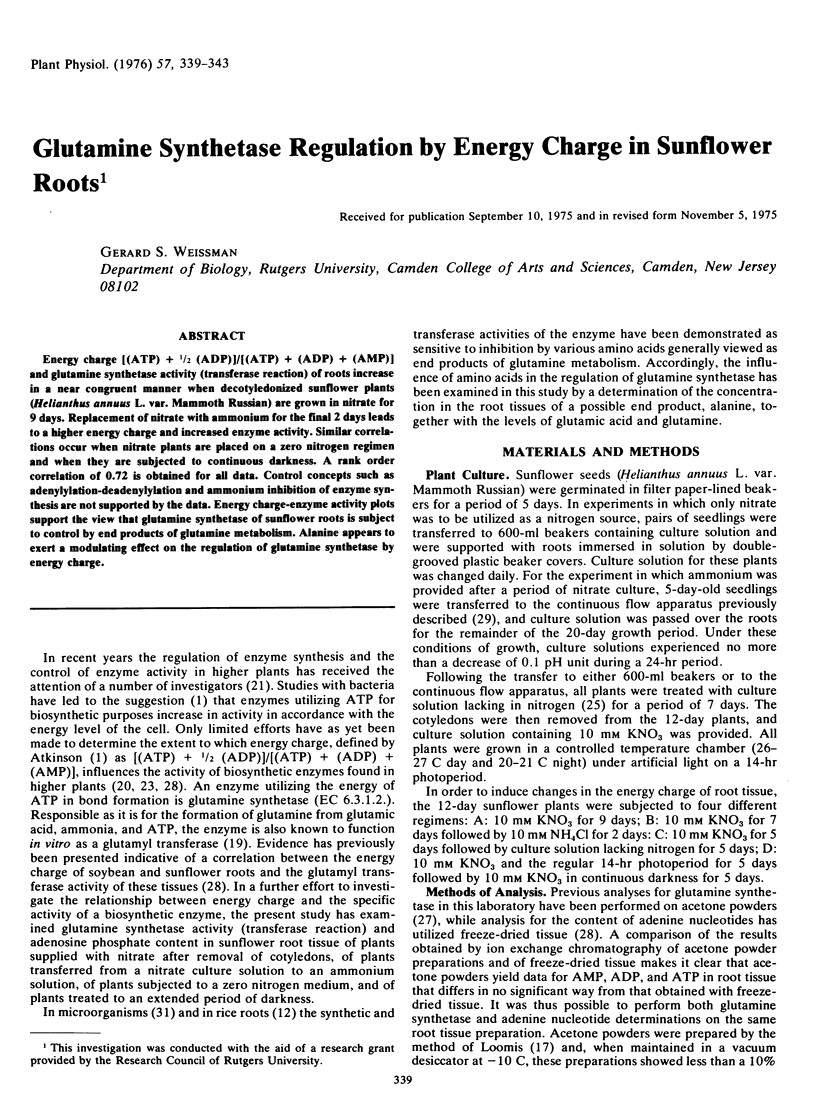
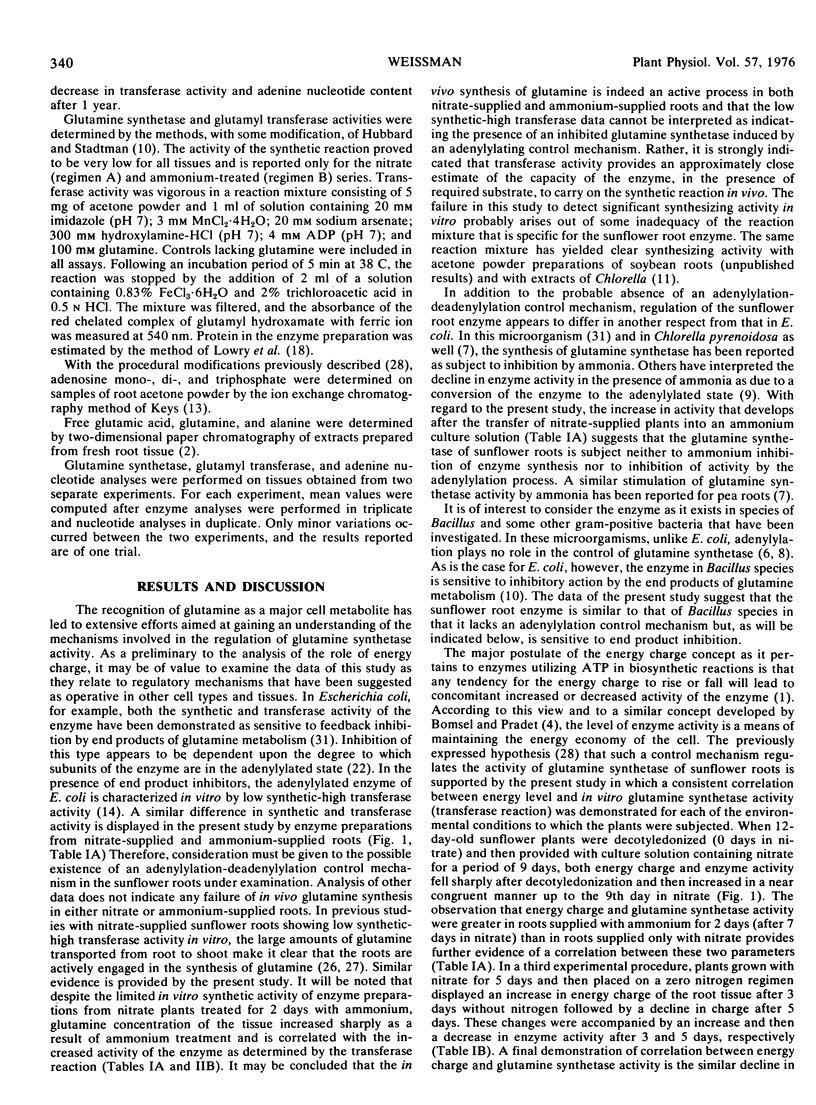
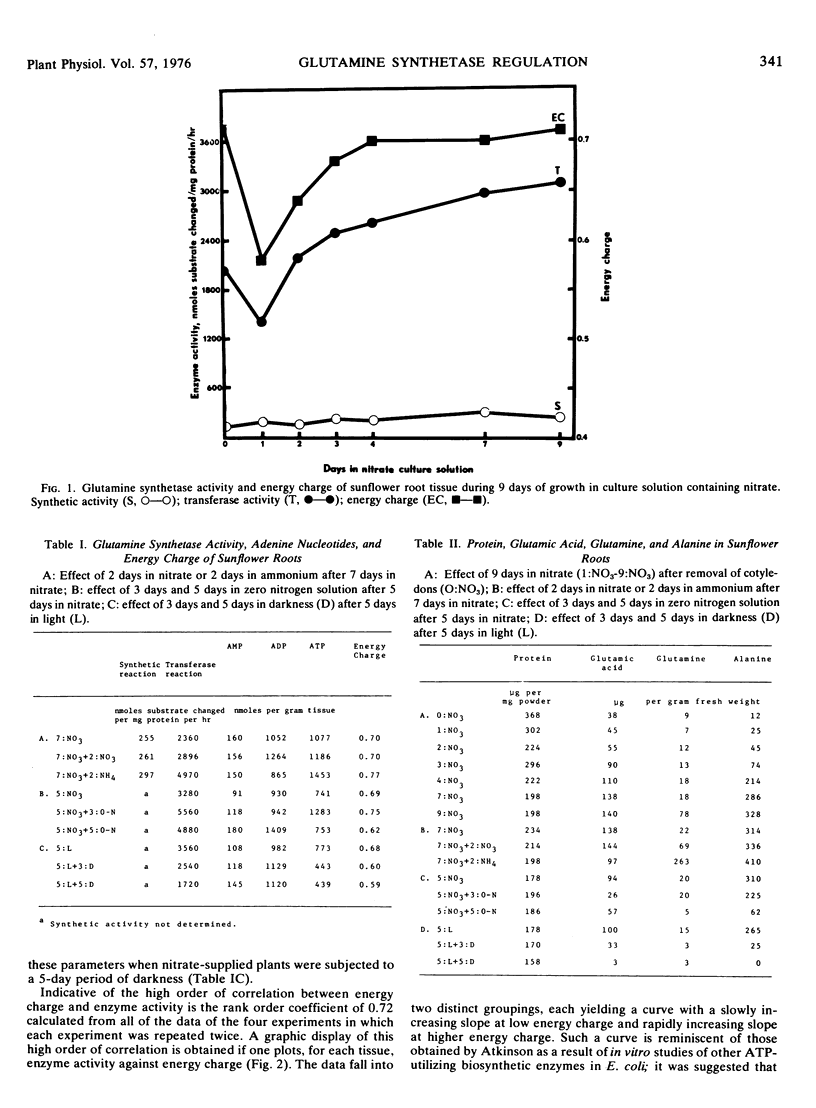
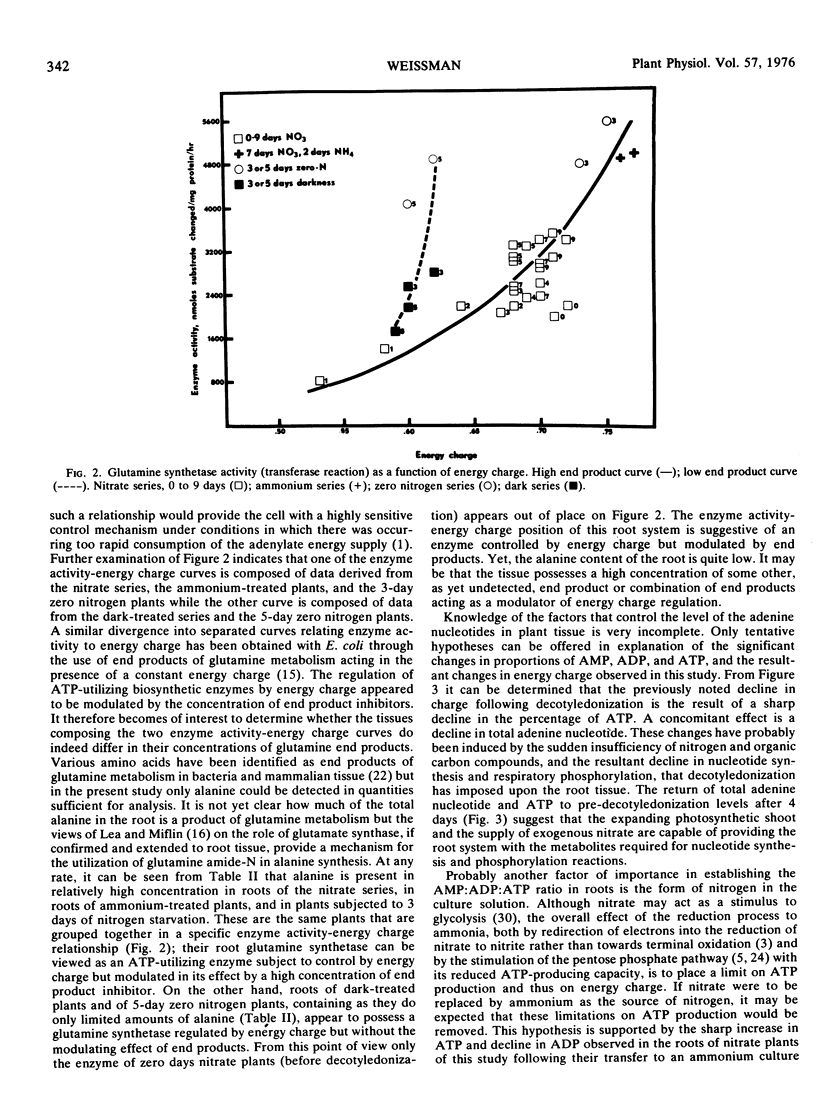
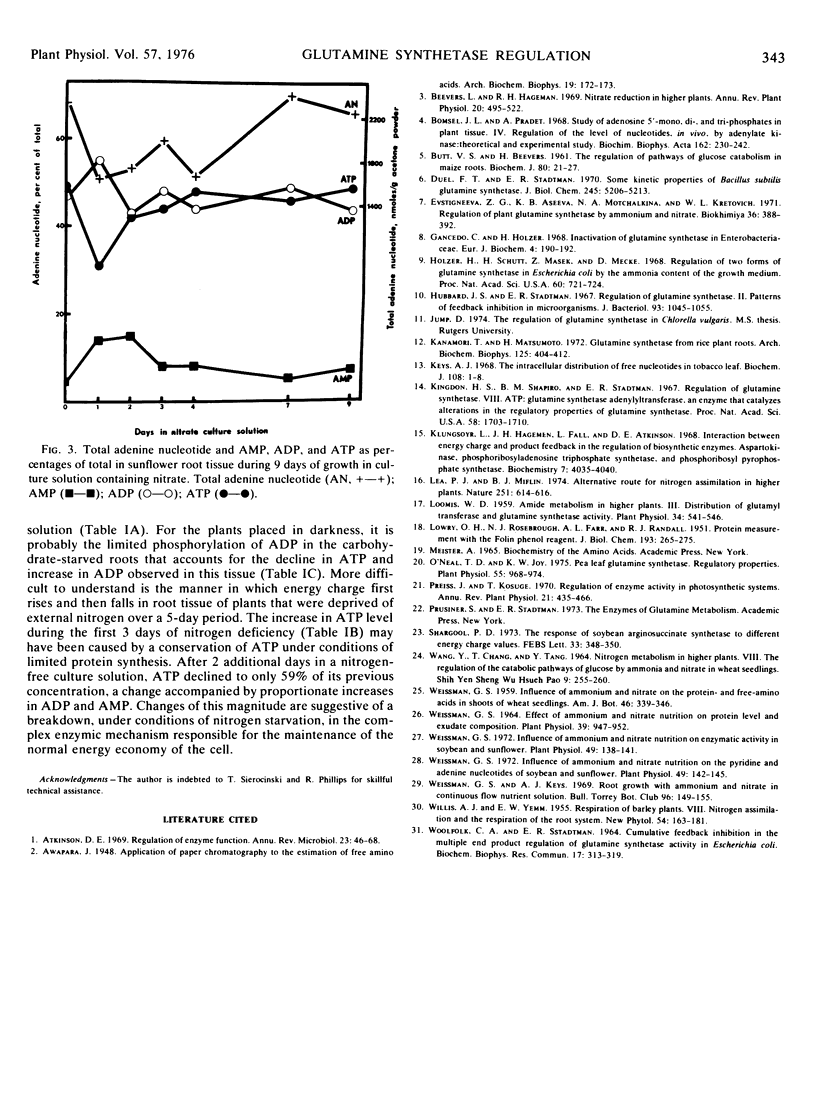
Selected References
These references are in PubMed. This may not be the complete list of references from this article.
- Atkinson D. E. Regulation of enzyme function. Annu Rev Microbiol. 1969;23:47–68. doi: 10.1146/annurev.mi.23.100169.000403. [DOI] [PubMed] [Google Scholar]
- BUTT V. S., BEEVERS H. The regulation of pathways of glucose catabolism in maize roots. Biochem J. 1961 Jul;80:21–27. doi: 10.1042/bj0800021. [DOI] [PMC free article] [PubMed] [Google Scholar]
- Bomsel J. L., Pradet A. Study of adenosine 5'-mono-,di- and triphosphates in plant tissues. IV. Regulation of the level of nucleotides, in vivo, by adenylate kinase: theoretical and experimental study. Biochim Biophys Acta. 1968 Aug 20;162(2):230–242. doi: 10.1016/0005-2728(68)90105-9. [DOI] [PubMed] [Google Scholar]
- Deuel T. F., Stadtman E. R. Some kinetic properties of Bacillus subtilis glutamine synthetase. J Biol Chem. 1970 Oct 25;245(20):5206–5213. [PubMed] [Google Scholar]
- Evstigneeva Z. G., Aseeva K. B., Mochalkina N. A., Kretovich V. L. Regulatsiia gliutaminsintetazy rastenii ammoniem i nitratom. Biokhimiia. 1971 Mar-Apr;36(2):388–392. [PubMed] [Google Scholar]
- Gancedo C., Holzer H. Enzymatic inactivation of glutamine synthetase in Enterobacteriaceae. Eur J Biochem. 1968 Apr 3;4(2):190–192. doi: 10.1111/j.1432-1033.1968.tb00192.x. [DOI] [PubMed] [Google Scholar]
- Holzer H., Schutt H., Masek Z., Mecke D. Regulation of two forms of glutamine synthetase in Escherichia coli by the ammonia content of the growth medium. Proc Natl Acad Sci U S A. 1968 Jun;60(2):721–724. doi: 10.1073/pnas.60.2.721. [DOI] [PMC free article] [PubMed] [Google Scholar]
- Hubbard J. S., Stadtman E. R. Regulation of glutamine synthetase. II. Patterns of feedback inhibition in microorganisms. J Bacteriol. 1967 Mar;93(3):1045–1055. doi: 10.1128/jb.93.3.1045-1055.1967. [DOI] [PMC free article] [PubMed] [Google Scholar]
- Kanamori T., Matsuoto H. Glutamine synthetase from rice plant roots. Arch Biochem Biophys. 1972 Sep;152(1):404–412. doi: 10.1016/0003-9861(72)90230-5. [DOI] [PubMed] [Google Scholar]
- Keys A. J. The intracellular distribution of free nucleotides in the tobacco leaf. Formation of adenosine 5'-phosphate from adenosine 5'-triphosphate in the chloroplasts. Biochem J. 1968 Jun;108(1):1–8. doi: 10.1042/bj1080001. [DOI] [PMC free article] [PubMed] [Google Scholar]
- Kingdon H. S., Shapiro B. M., Stadtman E. R. Regulation of glutamine synthetase. 8. ATP: glutamine synthetase adenylyltransferase, an enzyme that catalyzes alterations in the regulatory properties of glutamine synthetase. Proc Natl Acad Sci U S A. 1967 Oct;58(4):1703–1710. doi: 10.1073/pnas.58.4.1703. [DOI] [PMC free article] [PubMed] [Google Scholar]
- Klungsoyr L., Hagemen J. H., Fall L., Atkinson D. E. Interaction between energy charge and product feedback in the regulation of biosynthetic enzymes. Aspartokinase, phosphoribosyladenosine triphosphate synthetase, and phosphoribosyl pyrophosphate synthetase. Biochemistry. 1968 Nov;7(11):4035–4040. doi: 10.1021/bi00851a034. [DOI] [PubMed] [Google Scholar]
- LOWRY O. H., ROSEBROUGH N. J., FARR A. L., RANDALL R. J. Protein measurement with the Folin phenol reagent. J Biol Chem. 1951 Nov;193(1):265–275. [PubMed] [Google Scholar]
- Lea P. J., Miflin B. J. Alternative route for nitrogen assimilation in higher plants. Nature. 1974 Oct 18;251(5476):614–616. doi: 10.1038/251614a0. [DOI] [PubMed] [Google Scholar]
- Loomis W. D. Amide Metabolism in Higher Plants. III. Distribution of Glutamyl Tranferase and Glutamine Synthetase Activity. Plant Physiol. 1959 Sep;34(5):541–546. doi: 10.1104/pp.34.5.541. [DOI] [PMC free article] [PubMed] [Google Scholar]
- O'neal T. D., Joy K. W. Pea leaf glutamine synthetase: regulatory properties. Plant Physiol. 1975 Jun;55(6):968–974. doi: 10.1104/pp.55.6.968. [DOI] [PMC free article] [PubMed] [Google Scholar]
- Shargool P. D. The response of soy bean argininosuccinate synthetase to different energy charge values. FEBS Lett. 1973 Jul 15;33(3):348–350. doi: 10.1016/0014-5793(73)80227-3. [DOI] [PubMed] [Google Scholar]
- Weissman G. S. Effect of Ammonium and Nitrate Nutrition on Protein Level and Exudate Composition. Plant Physiol. 1964 Nov;39(6):947–952. doi: 10.1104/pp.39.6.947. [DOI] [PMC free article] [PubMed] [Google Scholar]
- Weissman G. S. Influence of ammonium and nitrate nutrition on enzymatic activity in soybean and sunflower. Plant Physiol. 1972 Feb;49(2):138–141. doi: 10.1104/pp.49.2.138. [DOI] [PMC free article] [PubMed] [Google Scholar]
- Weissman G. S. Influence of ammonium and nitrate nutrition on the pyridine and adenine nucleotides of soybean and sunflower. Plant Physiol. 1972 Feb;49(2):142–145. doi: 10.1104/pp.49.2.142. [DOI] [PMC free article] [PubMed] [Google Scholar]


